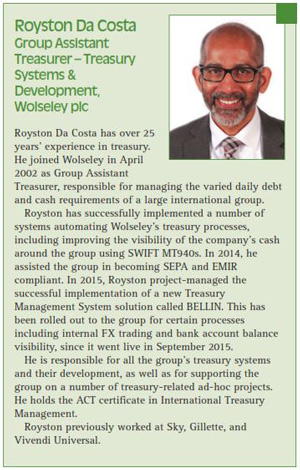

- Royston Da Costa
- Assistant Group Treasurer, Ferguson plc
by Royston da Costa, Group Assistant Treasurer, Treasury Systems & Development, Wolseley plc
In November 2013 (TMI edition 221) Royston Da Costa published an article in TMI outlining the journey that Wolseley’s treasury has undertaken to enhance both financial and operational efficiency, leveraging a combination of treasury technology and banking solutions. In this edition, he provides an update on the most recent stages of this journey.
Key Points
- Wolseley’s treasury has, since 2006, undergone a radical transformation to enhance its financial and operational efficiency
- In order to improve group liquidity and cash visibility a successful cash pooling programme was implemented in 2010
- Technological solutions such as electronic dealing from MyTreasury and bank connectivity have been harnessed to improve cash visibility further, and RegisTR and BELLIN’s tm5 provide the hub for treasury technology infrastructure
- The article outlines future plans including leasing, commodity hedging and improved cash flow forecasting
The journey’s starting point
Until 2006, treasury activities were managed using a series of spreadsheets, with a large number of labour-intensive processes, such as confirmation transmission and matching, and manual transfer of data to ancillary systems such as the general ledger, consolidation system and electronic banking. In 2006, we made the decision to implement a treasury management system (TMS), which was supplemented in 2008 by automated confirmation matching. We recognised that the TMS was an essential platform to enable us to develop more sophisticated treasury strategies and support the evolving needs of the business more effectively in the future, a view that has since been strongly validated.

Cash visibility and control
As the company has grown in both scale and geographic scope, managing group liquidity and risk has become a more significant challenge. Key to overcoming this was to maximise visibility over cash, which is a highly complex undertaking given that we have around 500 bank accounts with 78 banks, 41 of which are based in the United States. Historically, this involved obtaining balance information from business units by email and collating this centrally on a spreadsheet. A key step in achieving our treasury objectives was the introduction of a global cash pooling programme, which we implemented with Bank Mendes Gans (BMG) in 2010. We had a variety of objectives: in particular, by improving group liquidity, we could leverage cash surpluses across the group to reduce the need for external financing and therefore reduce bank charges. We would also improve cash visibility which would enable us to manage our cash and risk more strategically.
The solution involved two cash pools in Europe and North America respectively (now consolidated into one pool), each of which included multiple currencies. As a result, we improved our group liquidity position by €700m, which had a major impact on our financing needs and costs. We achieved better visibility and control over our global cash, therefore enabling treasury to manage our cash flow more effectively.
There were a number of factors that contributed to the success of our cash pooling programme:
- Senior management support. Obtaining senior management sponsorship was vital to ensure that we had access to the right resources when necessary, and helped to ensure common objectives at a group level.
- Expert advice. Involving legal and tax early in the process meant that we could identify and address challenges such as local regulatory requirements early on and ensure that the cash pooling solution was appropriate to our organisational structure.
- Education and co-operation. As cash pooling represents a major change from a cash and treasury management perspective, it was important to spend time with subsidiaries to explain how cash pooling would work in practice, and the group-wide benefits of cash pooling.
- Maintaining relationships. Finally, we had approached a number of our relationship banks as potential providers of our cash pooling solution, so it was important to debrief them fully on the reasons why we had not opted to work with them on this project.
Building on foundations
Our treasury technology framework and cash pooling programme soon proved to be firm foundations during a period of significant organisational change at Wolseley in 2011. This provided further momentum in continuing on our treasury transformation journey, including a renewed focus on treasury technology to improve cash visibility and efficiency.[[[PAGE]]]
Electronic dealing
For example, we made the decision to implement 360T (now part of the Deutsche Börse Group) for online dealing, which we integrated with our TMS to enhance control over the dealing process and improve straight-through processing. By dealing electronically, we could also seek competitive quotes, therefore making the dealing process more transparent and demonstrating better price discovery. Initially, we implemented electronic dealing for external FX deals but in 2012 we expanded this to our subsidiaries for internal dealing. We first executed our internal deals to create a consolidated position, which we then use to deal externally, allowing us to reduce the number of external deals we transact. In 2013, we implemented MyTreasury for online dealing of money market funds (MMFs). This allowed us to expand our investment portfolio to MMFs that are highly secure (AAA-rated), diversified instruments, achieve STP for MMFs and produce better quality reporting.
As well as integrating with external ancillary systems, we also automated the interface between our TMS and general ledger to streamline the production of treasury journals and provide better information to our accounting department, whilst reducing the administrative burden in treasury. We also started to import interest rates and FX rates automatically from Reuters into both the TMS and ERP to enable regular revaluation of deals.
Bank connectivity
In addition to streamlining the way we operated within treasury, we needed to improve the way that we collated bank account information, in order to achieve better visibility and control of cash. We decided to import MT940 messages (end of day bank statements) from our banks globally via Bank Mendes Gans into our TMS. This proved a relatively straightforward process, although not all our banks supported MT940: in these cases, we automated the manual submission procedure. However, the project has been very successful in providing a consistent view of cash information globally. So far, we have not considered implementing SWIFT to further rationalise our bank connections, although we may do so in the future.
As a result of these initiatives, we achieved an efficient treasury technology framework which in turn allowed us to optimise our cash management infrastructure and decision-making. By 2012, we had improved group liquidity by more than €0.7bn and made interest cost savings of €0.7m each year as a result of improved cash visibility. Internally, we had automated processes and connectivity more fully, reducing the administrative burden, improving services that treasury provides to the rest of the group, and enhancing security and control.
Changing dynamics
Inevitably, new business demands emerge and technology evolves, so we continue to be proactive in adapting our treasury technology infrastructure and reviewing our activities over time.
In 2014, we selected Unavista from the London Stock Exchange, which we integrated with our TMS for European Market Infrastructure Regulation (EMIR) reporting, and as a result, achieved compliance before the required deadline. In 2015, after having used our previous TMS for nine years, we made the decision to implement a new solution and selected tm5 from BELLIN (figure 1), which now provides the hub for our treasury technology infrastructure, and is used in group treasury in London and in Switzerland.
It is not only external demands that are changing, but our internal requirements are evolving too. Working capital is becoming an increasingly important metric at Wolseley, for example, and we are actively supporting business units in this area. Our net debt is cyclical, with sales increasing in the summer, an increase in inventory and a final dividend payment to shareholders towards the end of the calendar year. This means our net debt is highest at this point in the year. As a result, we provide liquidity to subsidiaries where necessary and our ability to do so is greatly enhanced as a result of the high level of cash visibility and control from which we now benefit. It is more cost-effective to secure financing at a group level, rather than at individual subsidiary level, as we can leverage our higher credit rating. In addition, we are making increasing use of a variety of working capital techniques such as supply chain financing, receivables financing etc. as appropriate.
Future plans

Looking ahead, we have a variety of initiatives either planned or at different stages of delivery, including leasing, commodity hedging, and improving our cash flow forecasting. We are also keen to take advantage of new opportunities such as bank account interest reconciliation and achieving a more automated approach to bank account management (BAM).
We will continue to review our credit facilities to ensure that we maintain reliable and cost-effective access to financing with sufficient headroom to meet unexpected liquidity requirements and facilitate growth. We will also continue to monitor working capital metrics closely, and work with business units to support their liquidity and working capital needs and support their activities.
Royston is giving a 1 day training session on Cloud Based Treasury Solutions and TMS selection & implementation from the perspective of the working corporate treasurer in Brussels on July 19th.
For more information or to book your place, contact Jamie Lawes at [email protected] or click the image below:











